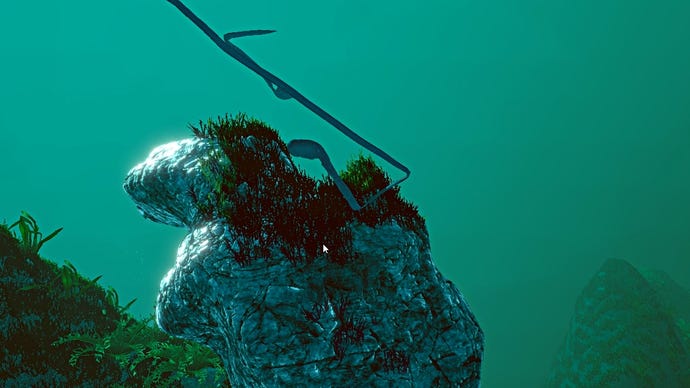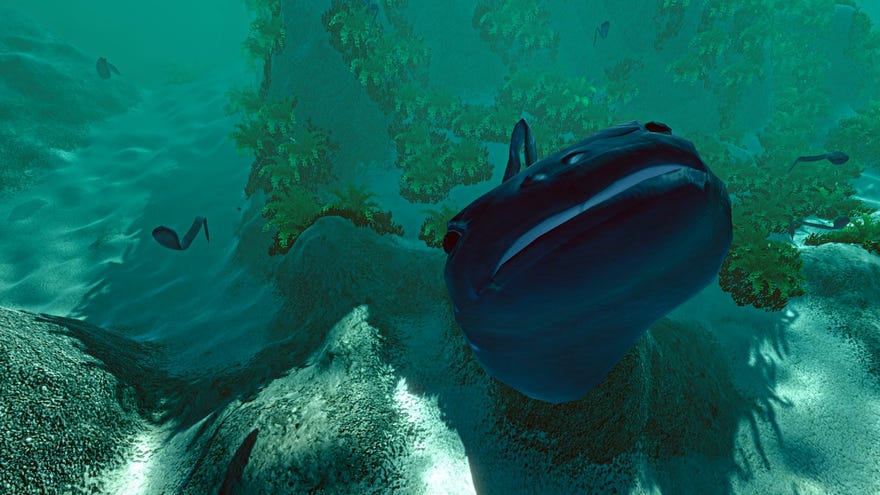How the mind of a virtual eel brought my PC to a standstill
Sorry Miss Jackson.
You could describe the Teneon as an eel. To be fair, though, you could also describe it as “a quaver with erectile dysfunction”, “some sort of depressing biopunk yo-yo”, or “the result of a tadpole getting in a teleporter accident with a belt”. It is a deeply unfortunate beast, and spends its days paddling glumly around a shallow sea in search of ferns. It does this by thrashing its head constantly up and down, so it appears to be constantly throwing accusatory glances at god.
Alas, however, the existence of this heartbreaking toad-on-a-rope is entirely its own fault; I may have set up the world around it, but I kept my hands out of the machinery of life. The blame for the Teneon’s flailing necktie of a body lies firmly at the door of natural selection - or at least the astonishing simulation of it that lies at the heart of Tom Johnson’s Ecosystem.
I was introduced to this game just shy of two years ago, as I attended EGX Rezzed with the mission of “finding every game on exhibition featuring eels”. It was in a much, much more basic state then, of course. I've written about it since. And yet now, two years on from discovering Ecosystem, and in the week that the game launches on Steam in Early Access, there’s something very fitting about my first go with the new build producing an eel.
Many games, over the years, have had a go at being the theoretical “evolution simulator” software toy that people like me have spent their lives dreaming of. Indeed, Ecosystem is by no means the only game doing interesting things on that front right now. But in my opinion, it’s the most immediately impressive.
In premise, it’s not complex at all. You create an oceanic landscape with sediment beds, rock formations, currents and the like, and seed it with a few hardy plants. As the plants spread out, they are able to support browsing creatures, so you pop in a few protoplasmic lumps to get things started. Then the game takes over, and things get wild.

Ecosystem’s creatures have synthetic DNA, which governs what they eat, how they reproduce, their biomechanical structure (skin, muscle, bone), and - most importantly - the brain controlling it all.
They do not swim using pre-written animations: they flap about with whatever body parts they have, in an entirely aimless fashion, applying torque at the joints and resistance across flat surfaces, to move through the water around them. And as you might imagine, most of them are absolutely garfield at this, early on. Of your first generation of creatures, most will die without ever having tasted food.
This bastard had, with no intervention, taught itself breaststroke.
But some will, through chance, struggle miserably towards a plant, reach it, and have just enough energy left to reproduce. Some of their offspring will, through chance mutation, amplify the structural quirks which allowed their parents to survive. And so on: the rest of the process very literally writes itself, with your pool of creatures splitting into a number of successful archetypes - aka species - which get incrementally better at living with each successive generation.
And despite me absolutely roasting it, the Teneon in my initial play was a wild success. It was one of the first stable phenotypes to emerge from the hopeless free-for-all of the early days, and it managed to remain relatively unchanged in form, even while the rest of the gene pool was busy branching out into much stranger and more complex forms.

There was a big flat disc with beefy, pinwheeling appendages at the edge, whose deal I was never quite sure of. A macropredator like a plesiosaur amputee, which migrated between the various herbivore breeding sites for seasonal feasts. Another sort of eel that was all head and very little tail, that somehow preyed on the aforementioned predators. Other things, which lived a generation or two but then failed spectacularly as they were outcompeted.
And then there was my favourite creature, which was a sort of bipedal frog that propelled itself along by actually kicking with its back legs. These weren’t prefab legs, either, “evolved” ex nihilo from a hidden toolkit of parts. These were appendages that had started out as flappy bits of nonsense generations earlier, and had progressively been refined into three-jointed, paired structures with identifiable feet/flippers, kicking in the right rhythm to move the beast along at a fair clip. This bastard had, with no intervention, taught itself breaststroke.

A few generations after the emergence of this virtuoso pseudofrog, the game started slowing down massively, guzzling up vast reserves of RAM and processor time in the process. It seemed a bit odd, given the relatively constrained virtual world my PC was being asked to simulate, and so I emailed Johnson to ask what might be going on.
“I just fixed that bug yesterday,” he said in reply. “It turned out some creatures could evolve extremely large brains and use up all the CPU resources.” Just let that sit with you for a moment. Extremely large brains.
“It turned out some creatures could evolve extremely large brains and use up all the CPU resources.”
Now, while I’d love to pretend that my misshapen bestiary had become self-aware, the truth isn’t much less astonishing. You see, every creature in Ecosystem has a fully simulated brain - something called a “pipeline computer”, which feeds data from sense organs through a big load of information… ropes, which then send out signals to contract muscles in specific body parts. I don’t know enough about either brains or computers to be more precise than that, but I can tell you that these brains evolve through the same iterative process as the creatures’ physical forms.
And as it turned out, my good old Teneon had evolved quite the talent for introspection. Its tail was made out of many individual body parts, you see, all of which were outputs for its pipeline computer brain. And over successive generations, it had been developing a mind capable of optimising the tiny, tortured twitches of these tail segments to generate infinitesimal efficiency gains. “Like when you approximate pi with an infinite series,” Johnson summarised, showing me screenshots of a similar brain he found when fixing the bug.

Admittedly, I’m happier now that kink has been ironed out of the game, as I’d like to run it faster and for longer to see what happens. But honestly, if the statement “a simulated eel evolved a brain large enough to bring my PC to its knees” doesn’t convince you that this is the evolution simulator to get excited about, I am not sure what will.

